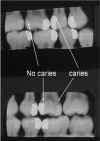Diagnostic performance of cone-beam computed tomography on detection of mechanically-created artificial secondary caries
- PMID: 22232722
- PMCID: PMC3251786
- DOI: 10.5624/isd.2011.41.4.143
Diagnostic performance of cone-beam computed tomography on detection of mechanically-created artificial secondary caries
Abstract
Purpose: The aim of this study was to compare the diagnostic accuracy of cone-beam computed tomography (CBCT) images and bitewing images in detection of secondary caries.
Materials and methods: One hundred and twenty proximal slots of Class II cavities were randomly prepared on human premolar and molar teeth, and restored with amalgam (n=60) and composite resin (n=60). Then, artificial secondary caries lesions were randomly created using round steel No. 4 bur. The teeth were radiographed with a conventional bitewing technique and two CBCT systems; Pax-500ECT and Promax 3D. All images were evaluated by five observers. The area under the receiver operating characteristic (ROC) curve (A(z)) was used to evaluate the diagnostic accuracy. Significant difference was tested using the Friedman test (p value<0.05).
Results: The mean A(z) values for bitewing, Pax-500ECT, and Promax 3D imaging systems were 0.882, 0.995, and 0.978, respectively. Significant differences were found between the two CBCT systems and film (p=0.007). For CBCT systems, the axial plane showed the greatest A(z) value.
Conclusion: Based on the design of this study, CBCT images were better than bitewing radiographs in detection of secondary caries.
Keywords: Cone Beam CT; Dental Caries; Diagnosis; Radiography, Bitewing.
Figures







Similar articles
-
Comparison of accuracy cone-beam computed tomography and digital bitewing radiography for detection of recurrent caries under various restorative materials: in vitro study.Oral Radiol. 2023 Oct;39(4):722-730. doi: 10.1007/s11282-023-00690-x. Epub 2023 Jun 19. Oral Radiol. 2023. PMID: 37335388
-
An in vitro comparison of diagnostic accuracy of cone beam computed tomography and phosphor storage plate to detect simulated occlusal secondary caries under amalgam restoration.Dent Res J (Isfahan). 2015 Mar-Apr;12(2):161-6. Dent Res J (Isfahan). 2015. PMID: 25878682 Free PMC article.
-
Diagnostic accuracy of different display types in detection of recurrent caries under restorations by using CBCT.Dentomaxillofac Radiol. 2016;45(6):20160099. doi: 10.1259/dmfr.20160099. Epub 2016 Jul 4. Dentomaxillofac Radiol. 2016. PMID: 27319604 Free PMC article.
-
The detection accuracies for proximal caries by cone-beam computerized tomography, film, and phosphor plates.Oral Surg Oral Med Oral Pathol Oral Radiol Endod. 2011 Jan;111(1):103-8. doi: 10.1016/j.tripleo.2010.06.025. Epub 2010 Oct 16. Oral Surg Oral Med Oral Pathol Oral Radiol Endod. 2011. PMID: 20952219
-
Ex vivo evaluation of new 2D and 3D dental radiographic technology for detecting caries.Dentomaxillofac Radiol. 2016;45(3):20150281. doi: 10.1259/dmfr.20150281. Epub 2015 Dec 16. Dentomaxillofac Radiol. 2016. PMID: 26670605 Free PMC article.
Cited by
-
Effect of Filtration and Thickness of Cross-Sections of Cone Beam Computed Tomography Images on Detection of Proximal Caries.J Dent (Tehran). 2017 Jul;14(4):223-230. J Dent (Tehran). 2017. PMID: 29285032 Free PMC article.
-
Comparison of accuracy cone-beam computed tomography and digital bitewing radiography for detection of recurrent caries under various restorative materials: in vitro study.Oral Radiol. 2023 Oct;39(4):722-730. doi: 10.1007/s11282-023-00690-x. Epub 2023 Jun 19. Oral Radiol. 2023. PMID: 37335388
-
An in vitro comparison of diagnostic accuracy of cone beam computed tomography and phosphor storage plate to detect simulated occlusal secondary caries under amalgam restoration.Dent Res J (Isfahan). 2015 Mar-Apr;12(2):161-6. Dent Res J (Isfahan). 2015. PMID: 25878682 Free PMC article.
-
In vitro comparison of high-definition US, CBCT and periapical radiography in the diagnosis of proximal and recurrent caries.Dentomaxillofac Radiol. 2021 Dec 1;50(8):20210026. doi: 10.1259/dmfr.20210026. Epub 2021 May 12. Dentomaxillofac Radiol. 2021. PMID: 33979235 Free PMC article.
-
Evaluation of a Decision Support System Developed with Deep Learning Approach for Detecting Dental Caries with Cone-Beam Computed Tomography Imaging.Diagnostics (Basel). 2023 Nov 18;13(22):3471. doi: 10.3390/diagnostics13223471. Diagnostics (Basel). 2023. PMID: 37998607 Free PMC article.
References
-
- Scarfe WC, Farman AG. Cone-beam computed tomography. In: White SC, Pharoah MJ, editors. Oral radiology: principle and interpretation. 6th ed. St. Louis: Mosby; 2009. pp. 225–242.
-
- Akdeniz B, Gröndahl H, Magnusson B. Accuracy of proximal caries depth measurements: comparison between limited cone beam computed tomography, storage phosphor and film radiography. Caries Res. 2006;40:202–207. - PubMed
-
- Tsuchida R, Araki K, Okano T. Evaluation of a limited cone-beam volumetric imaging system: comparison with film radiography in detecting incipient proximal caries. Oral Surg Oral Med Oral Pathol Oral Radiol Endod. 2007;104:412–416. - PubMed
-
- Haiter-Neto F, Wenzel A, Gotfredsen E. Diagnostic accuracy of cone beam computed tomography scans compared with intraoral image modalities for detection of caries lesions. Dentomaxillofac Radiol. 2008;37:18–22. - PubMed
-
- Young SM, Lee JT, Hodges RJ, Chang TL, Elashoff DA, White SC. A comparative study of high-resolution cone beam computed tomography and charge-coupled device sensors for detecting caries. Dentomaxillofac Radiol. 2009;38:445–451. - PubMed

